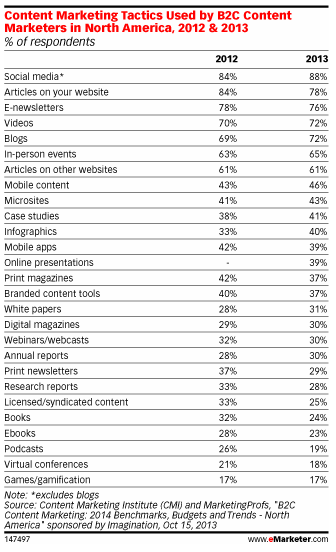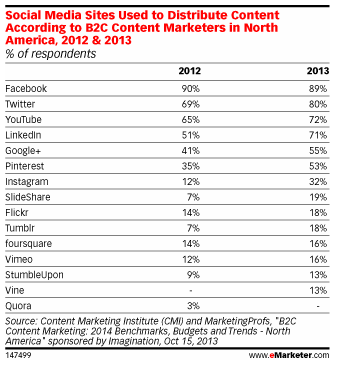
At Ghost Blog Writers we work with a lot of small businesses.
But we’ve also worked with our share of B2C companies. We’re talking Internet Retailer Top 500 companies that have thousands of products and hundreds of thousands of customers (if not millions).
We’ve seen great success with the small and medium B2B businesses with blogging efforts. Those companies can invest $5,000 annually in a blogging program and see long-term payback of 5x or so over a few years.
When you’re talking the B2B world it makes sense to invest in blogging because the new customers you bring in can be worth tens of thousands of dollars over a couple years. And the blog posts you invest in are there forever unlike advertising.
It is always interesting to see how B2C companies do with content marketing. The average orders are smaller. The lifetime value might not be as high and you have to bring in a lot more customers to justify the ROI of content marketing.
Well a new study shared on eMarketer shows that B2C companies are investing quite a bit into content marketing.
From Content Marketing Used By B2C Companies In 2012, 2013:
The written word also emerged as a popular medium for content marketing messages—78% said they used articles posted on their website, 76% employed electronic newsletters and 72% had blogs in their content marketing mix. Videos were also a popular content marketing medium, employed by 72% of respondents. B2C marketers saw significantly less value in podcasts, video conferences and games and gamification efforts.
Here is the first chart of interest from the article:
It’s always interesting to me when studies break apart blogging from things like articles on a website or even from video and case studies.
Blogging can take care of all these things. It’s the perfect platform for putting articles on your website. And you can use case studies to create some really great (and really popular) blog posts.
Maybe it’s just me.
Social Media Over Blogging?
It’s always interesting when these studies come out that companies put more importance on social media than something they own like a blog. It’s not uncommon to see these types of results where social media is at 88% and blogging is at 72%.
There seems to be more instant gratification with social media than there is with blogging, which is a long-term strategy. I can understand it more with B2C companies that are under pressure to bring in new customers all the time.
The thing we always warn about when it comes to this type of strategy is that when you put content on social media sites you’re giving up ownership of the content.
That’s the biggest issue.
There are two more issues, though.
The second biggest one is that you don’t control the platform. We’ve seen it with Facebook mostly. Companies invest in customer graphics and strategies only to see Facebook change the rules. That leaves these companies scrambling to change their strategy to try and get in the Newsfeed.
The third item is that content has a very short lifespan on social media. There is a ton of content on the sites and even if you get a hit piece you’re going to lose it in a day or so. Something else will come along.
With content on your site the content lives on forever through search, social sharing and your email newsletter programs. You can always tap into the archives to revive your content. It’s always there.
It’s easier to find a great blog post from 2010 than it is to find a Facebook update from 2010.
I think that’s why the second piece of the study is important.
On this one we see that companies are distributing content on social media sites. I think this is more about the social sites companies are using, but I’m sure some are using these sites to share their original content from articles and blogs.
We hope so.
The one that stood out most to me is the jump in LinkedIn use by B2c companies. I know that site works well for B2Bs, but that is a huge jump for B2Cs.
I’m going to have to look into that one.


